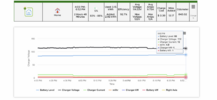20221229 3RWD
Member
Oh snap, all of that makes sense thanks. I understand and agree with the "stab-in" outlets. Coincidentally, I replaced this outlet a couple of years ago and upgraded it from a NEMA 5-15 to a NEMA 5-20 (no reason then, other than wanting a 20amp outlet consistent with a 20amp breaker).Sounds like voltage drop because of the telltale 8 amps. The car measures the voltage at first, before beginning charging, and then it will check how much it drops as it ramps up the current. If it sees drop more than a certain amount, then it will drop the current to 3/4 of what it was using. So that is what the 8 amps instead of 12 would show.
It's probably not just the heat sensor, because that almost always throws a visible error on the display.
A lot of builders put in those 120V outlets using the part on the back of the outlets called "stab-in". They are holes with little sharp teeth along the edges of the inside of the holes. You can strip the wire, and then just shove it in there, and the teeth scrape into the wire to kinda, sorta, make a weak connection. It's faster to get a bunch of outlets installed, but is generally crummy because those tiny teeth connections are a very small point of contact and are resistive, and after several years will usually stop working right.
So maybe pull that outlet and check. The outlets do still have the screw terminals on the side. So if it's using the stab-in holes, pull the wires out of that and wrap it around the screw on the side and tighten it up to make it a much better connection, and it won't have as much voltage drop, and that may fix that issue.
Or the wires may be loose at the other end where they are screwed into the breaker. Or, it may just be a really long run of the wire that is just going to have significant voltage drop regardless. That's not bad, but will keep dropping the current down to 8A. As @brkaus suggested, you might be able to turn the amps down to around 9 or 10 to start with, and that may keep it sustained without triggering that lowering.
I have no idea how long the wire run is, it's probably 30' at least from the breaker box on the south side of the garage to this north side outlet.
I will pull the outlet and check it for heat/smoke/fire and retighten the stuff. I didn't realize how sensitive the car/charger would be to voltage at level 1 charging?





